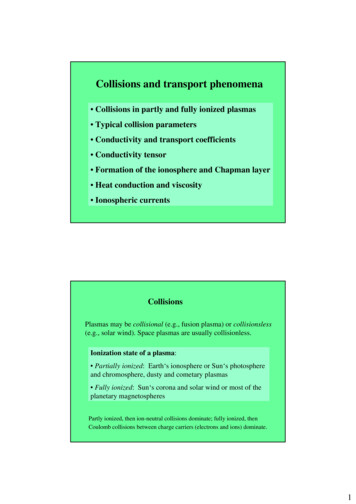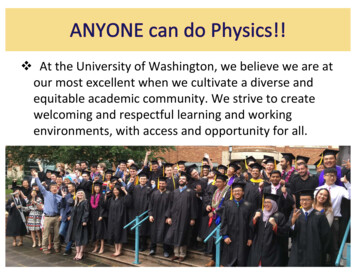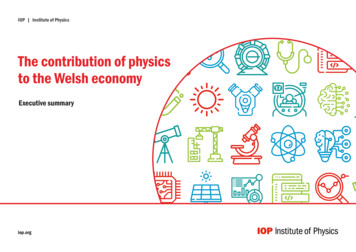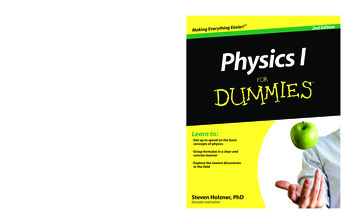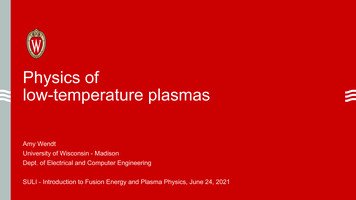
Transcription
Physics oflow-temperature plasmasAmy WendtUniversity of Wisconsin - MadisonDept. of Electrical and Computer EngineeringSULI - Introduction to Fusion Energy and Plasma Physics, June 24, 2021
Introduction: setting the stageA. Wendt, University of Wisconsin - Madison 2021
PHYSICS of low temperature plasmas thermodynamics statistical mechanics fluid dynamics classical mechanics waves electricity and magnetism atomic physics quantum chemistryA. Wendt, University of Wisconsin - Madison 2021https://gfycat.com/gifs/search/plasma globe
Low temperature plasmas at workionthrusterfinfet 3D transistorApple M1 processor “die” 9 mm16 BtransistorsA. Wendt, University of Wisconsin - Madison 2021https://www.flickr.com/photos/dlr de/41361769882/in/album-72157693770479701/
What is a low temperature plasma? What is a plasma? What is temperature? In what sense is the temperature low?Peeling back the “layers of the onion”A. Wendt, University of Wisconsin - Madison 2021
Plasma as the 4th state of matterDeformableA. Wendt, University of Wisconsin - Madison sma/physics.html
What is a low temperature plasma?A. Wendt, University of Wisconsin - Madison 2021
Temperature: elastic collisions thermalize populations elastic collisions - particles“bounce” off one another; kineticenergy is conserved energy becomes randomlydistributed among the particlesover time - this is thermalequilibriumA. Greg (Greg L at English Wikipedia) / Public domainA. Wendt, University of Wisconsin - Madison 2021
System energy is randomly distributed amongparticles through collisions Pairs of particles exchange energy in collisions,but for the system as a whole, the relativenumbers of particles for each energy does notchange. The shape of the distribution can be representedby a single parameter - temperature T Called “Maxwell-Boltzmann” or “Maxwellian”distribution 3/2g(E) 4πn(2πκT )E2E exp ( κT )concentration of particlesThermal Equilibrium𝛋T 3 eV𝛋T 5 eV𝛋T 10 eV κ 8.6 10 5 eV/K is the Boltzmann constant electron volts (eV) are units of energy 1.6 10 19 J κT 1 eV corresponds to T 11,600 K 1 eVA. Wendt, University of Wisconsin - Madison 2021particle energy E (eV)
Temperature case study: inductively coupled plasma AC currents in spiral antenna producehigh frequency electric fields insideplasma volume electrons (low mass!) are preferentiallyaccelerated by electric fields: Lorentz ForceF⃗q⃗a ⃗ (E ⃗ v ⃗ B)mm and heated electrons thermalize to κTe 1 10 eV atoms and ions remain near roomtemperature Many low temperature plasmas are NOTin thermal equilibrium: Te Tion TgasA. Wendt, University of Wisconsin - Madison 2021inductively coupled plasma
Elastic collisions: low-temp plasmas are often *not* in thermal equilibriumelectronatomUnequal masses: kinetic energy transfer is weakelectronelectronEqual masses: kinetic energy transfer is very efficientA. Wendt, University of Wisconsin - Madison 2021
High and low temperature (it’s all relative!) plasmasA. Wendt, University of Wisconsin - Madison 2021
High temperature vs. low temperature plasmasHigh TLow Tyesnorarefrequentplasma waveslikelydamped bycollisionssurfaceboundaries?rarecommonfusion reactionsmaybenousually fullyionized?collisions withneutrals?A. Wendt, University of Wisconsin - Madison 2021
Low temperature plasma superpowers:#1 Electron-neutral collisionsA. Wendt, University of Wisconsin - Madison 2021
Low-temperature plasmas are often partially ionizedPartially ionized plasmaA. Wendt, University of Wisconsin - Madison 2021Fully ionized plasma
nnnnnnn n nn nnnPartially ionized plasmasnnnnnnnnn nn n n nnnnnn nn nnnnnnnn nnn n nn nn n n nn nn n n n n nnnnnnnnnnnnnnn nnn n nnnnnnnionn positivennnnnnnn nn n electron n n nnnnnnneutralatomnnnnnnnn Collisions between electrons and neutralparticles play really, really important roles Electron-neutral inelastic collisions: ionization - sustains plasma excitation - results in photon emission dissociation - exotic chemistriesnA. Wendt, University of Wisconsin - Madison 2021nnn orn molecule
Where does the energy go in partially ionized plasmas?1 2 kinetic energy mv2 acceleration in EM fields:dv⃗⃗F ma ⃗ m q(E ⃗ v ⃗ B)dt electrons gain energy more readily from electricfields electron mass is smaller, but velocity is bigger electrons have high kinetic energy elastic collisions thermalize electron population inelastic electron-neutral collisions consumeelectron kinetic energy with important outcomesA. Wendt, University of Wisconsin - Madison 2021
Inelastic electron-neutral collisions If free electron kinetic energy issufficiently high, it may be utilized inseveral ways upon collisionA. Wendt, University of Wisconsin - Madison 2021
Electron-neutral inelastic collisions:what happens to electron kinetic energy?nnnnnA. Wendt, University of Wisconsin - Madison ationn*photonemissionnn nnproducts may be highlychemically reactive
Low temperature plasma superpowers:#2 Surfaces and plasma sheathsA. Wendt, University of Wisconsin - Madison 2021
Potential (voltage) profile across plasma sheaths form next to surfaces Contrast plasma to resistor-V0V0E⃗ resistorVE⃗ plasmasheathE⃗sheathx Resister voltage axial profile is linear.Vx-V0A. Wendt, University of Wisconsin - Madison 2020-V0Positive and negative charges respondto electric field, forming sheathsat electrodes. Ions accelerate intonegative electrode
What is a plasma sheath? Plasma sheath is a boundary layerbetween plasma and solid surface: container wall,electrodes, substrate, etc. Interior of plasma volume: Charges shift position to maintaincharge balancesheath electric field weak due to shielding byplasma Sheath region Strong electric field plasma density low unequal positive and negative chargedensities ions accelerated into surfaces removal of surface material ion implantationA. Wendt, University of Wisconsin - Madison 2020plasmawallselectrostaticpotential
Low temperature plasma superpowers:#3 Magnetic fields and low-T plasmasA. Wendt, University of Wisconsin - Madison 2021
Partially ionized plasmas: charged particles in magnetic field In the absence of collisions charges in magnetic field undergohelical orbits “guiding centers” follow magnetic fieldlines - magnetic confinementA. Wendt, University of Wisconsin - Madison 2021
Charged particles in magnetic fields Lorentz Force equation smaller mass, smaller orbit radius higher kinetic energy, higher orbit radius collisions with neutrals disrupt orbitalmotion - interfere with magneticconfinement plasmas at low gas pressures arebetter confined by magnetic field dueto reduced collision frequencyA. Wendt, University of Wisconsin - Madison 2021
Case study: planar magnetron sputter depositionA. Wendt, University of Wisconsin - Madison 2021
Case study: planar magnetron thin film deposition Magnetic field electrons confined ion orbit too big Electric field negative voltage applied to electrode sheath forms above “target” strong electric field ions accelerated into surface target atoms sputtered electrons released - “secondaryemission” secondary electrons enter plasmawith high energy due to accelerationin sheath Diffusion uncharged target atoms traverse theplasma some reach substrate and stick to formthin -orion-8-sputtering-system/A. Wendt, University of Wisconsin - Madison 2021
Parting commentsA. Wendt, University of Wisconsin - Madison 2021
PHYSICS of low temperature plasmas thermodynamics statistical mechanics fluid dynamics classical mechanics waves electricity and magnetism atomic physics quantum chemistryA. Wendt, University of Wisconsin - Madison 2021https://gfycat.com/gifs/search/plasma globe
Final thoughts Stop and smell the roses - savor the richness ofplasma physics; no need to rush. Delve into the various physics sub-disciplinesrelevant for plasmas - a great foundation forunderstanding plasmas. Plasma physicists use an odd collection of units get to know them and relevant conversion factors.Seek out shortcuts in plasma formulary and/ortextbook appendices. Embrace opportunities - the skills you acquire willbenefit you in ways you cannot imagine now. UW-Madison is home to world-renowned expertsin a breadth of plasma research areas - it is agreat place for graduate degrees in plasmas!A. Wendt, University of Wisconsin - Madison 2021
electrons (low mass!) are preferentially accelerated by electric fields: Lorentz Force and heated electrons thermalize to atoms and ions remain near room temperature Many low temperature plasmas are NOT in thermal equilibrium: a ⃗ F ⃗ m q m (E ⃗ v ⃗ B)⃗ κT e 1 10 eV T e T ion T gas
